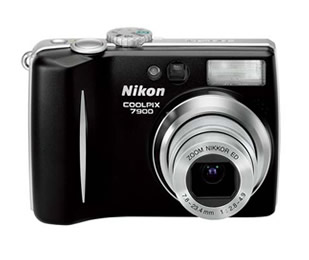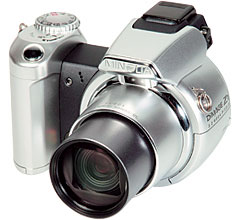





|
|
|
|
December 13, 2005
My highest unqualified digital camera endorsments
Here I go, a non-photographer shooting off my mouth about photography! Well, it's for a good cause; Glenn Reynolds is putting together a Carnival of the Digital Cameras. Frankly, Glenn's background in professional photography is a bit humbling, because I'm a total hack who just likes to have fun with a camera. My hope, though, is that with this post I might be able to help some similarly situated less than professional photographers, non- photographers, or even people who don't own a digital camera and don't want to read tech talk. While that great commenter, the recently deceased Steven Malcolm Anderson, used to praise my photos, I have no idea whether they're any good or not. I have absolutely no background in photography, and I never much enjoyed it because I'm just too lazy to take the rolls of film in and have them developed. It's too much of a hassle. But with the advent of quality digital photography, my attitude changed. Depending on memory (and whether or not you're willing to delete on the fly), there is no practical limit on how many photographs can be taken. This means that I can afford to be as bad a photographer as I want, with zero consequences. What I've found to be the best way to get a photo I consider half decent is to take a whole bunch of shots at whatever it is, and hope for the best. Occasionally I'll surprise myself, and occasionally I'll put the ones that surprise me into the blog. Until last summer, I used a 2.1 megapixel Epson PhotoPC 850Z. This camera is a relic now, but still a trusty workhorse -- good to keep in the car trunk. Finally I tired of the Epson's large size and slowness (the three second delay was infuriating), and I just wanted something with more detail. The problem is that there are so many damned choices that I just couldn't make up my mind. Because of my inexperience with photography (and love of things made deliberately simple), I decided upon the Nikon Coolpix 7900.  It's small, attractively designed with a black finish, has a large LCD screen, long lasting rechargeable battery, and it has a number of very slick, pre-customized settings designed for idiots like me. It excels at indoor, nighttime portrait shots, as it has a special feature which double flashes in just the right way. There are special settings for museums (no flash allowed!), outdoor scenes, sunsets, sports, landscapes, and architecture. (The latter displays has a grid you can line up with the buildings.) There's a lot more than I listed, of course, and I am sure professional photographers would tend to pass on this camera, because they like to control all the settings themselves. Naturally, there's a video feature, and the sound and picture quality are great. I don't do much videoblogging, but if I did I'd probably adjust the settings to a lower quality, as the default setting results in files too large for easy uploading and later streaming. PC World rated the Coolpix 7900 as one of the top 100 products of the year, and they review it here. Or, if you don't trust PC World, here's Steve's Digicams' review. These cameras sell for $325 to $400.00, which is odd, because I got mine for $319. (If you're looking for bargains, I suggest searching on Froogle, then running a resellerratings.com check on the seller. Often, prices that seem too good to be true are precisely that!) I heartily recommend this camera. A friend who bought one on my recommendation because he wanted something simple and foolproof was delighted, and thanked me. (Money was no object with this guy, but he's persnickety and it was a real relief to me that he liked it.) Here's a macro shot I took right out of the box, without any practice:

While I really can't fault this camera for someone possessed of my skills who wants to keep things simple, there are a couple of downsides which I think might apply to most of the smaller, newer cameras like this one. First, it's very difficult holding a camera this small completely still for a zoom shot, and this results in blurring which didn't happen with the larger body Epson camera. Second, I'd like a more powerful optical zoom, and most of these little cameras are only 3x optical. Third, the high megapixel format create files that are awkward to work with -- either to send as email attachments or to upload in blog posts. What that means is that I end up reducing the size dramatically, which sometimes makes me wonder why I bothered to buy a high megapixel camera in the first place. But that's not a complaint about the Coolpix camera. However, it does lead me to another camera review. Taking into account the limitations of this small camera, I began to miss my old Epson clunker, and I decided to buy a a more up-to-date, larger-sized camera with a more powerful zoom. Especially if you don't care about having over 5 megapixels, they're now incredibly -- even irresistibly -- cheap. I settled on the Minolta Dimage Z-1, which has a 10x optical zoom and 3.2-megapixels.  Steve's Digicams' review is here. It's a cool looking camera with a solid feel, and I paid only $143.00 for it. It works very well for the long distances, but of course the drawback is that it's larger -- which means you can't just throw it in your pocket and go. The Dimage Z1 has many nice automatic features, plus unlike the Coolpix it is possible for a photographer with advanced skills to set everything manually. The video is great too! In fact, what sold me on the camera was that a professional photographer had bought one and while he was showing it to me it took an accidental video (of the party we were both attending), and the "accident" is so good that I saved it and I've watched it repeatedly. I don't doubt that there are better cameras than the Minolta, but for the money I seriously doubt it. I would recommend either of these cameras without hesitation. Or both!
Carnivals like this trigger my consumer consumptivitis factor, and make me want what I don't have. I'm jealous, for example, of the Canon Digital Rebel, I'd like to have Bill Quick's waterproof Pentax, and I liked CatHouse's Sony DSC W-1 which was one of the cameras I passed over for the Nikon. (I see CatHouse also envies the Canon Digital Rebel, while Bill Hobbs has advice on which lens to buy the latter instead of the standard lens.) Geez, and if Charles Simmins's post is any indication, everyone wants a Canon Digital Rebel. Wish I had one, but I guess maybe I should wait for prices to come down, and then buy one when people are talking about something else. Nice Carnival!
posted by Eric on 12.13.05 at 03:23 PM
Comments
With the Nikon, the shutter seems to take the picture almost instantaneously, and it takes about a second to record it into memory. It takes a little longer with the special night portrait settings, though, because it fires the flash twice. Interestingly, a more geeky person than I went to the trouble of measuring "shutter delay and shot to shot cycle times" with a test system he designed and built: http://www.imaging-resource.com/PRODS/CP7900/CP79DATA.HTM As to the Minolta, the speed seems equally fast, and the same guy ran his tests on that one too: Eric Scheie · December 13, 2005 09:05 PM |
|
December 2006
WORLD-WIDE CALENDAR
Search the Site
E-mail
Classics To Go
Archives
December 2006
November 2006 October 2006 September 2006 August 2006 July 2006 June 2006 May 2006 April 2006 March 2006 February 2006 January 2006 December 2005 November 2005 October 2005 September 2005 August 2005 July 2005 June 2005 May 2005 April 2005 March 2005 February 2005 January 2005 December 2004 November 2004 October 2004 September 2004 August 2004 July 2004 June 2004 May 2004 April 2004 March 2004 February 2004 January 2004 December 2003 November 2003 October 2003 September 2003 August 2003 July 2003 June 2003 May 2003 May 2002 See more archives here Old (Blogspot) archives
Recent Entries
• Holiday Blogging
• The right to be irrational? • I'm cool with the passion fashion • Climate change meltdown at the polls? • If you're wrong, then so is God? • Have a nice day, asshole! • Scarlet "R"? • Consuming power while empowering consumption • Shrinking is growth! • My dirty thoughts
Links
Site Credits
|
|
What's the delay on both those cameras? That is, how long between pressing the button and the capture? My one complaint about the olympus I currently use is it sometimes takes about 4 seconds to take a picture if it can't figure out which idiot proof setting to use....